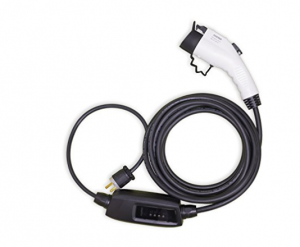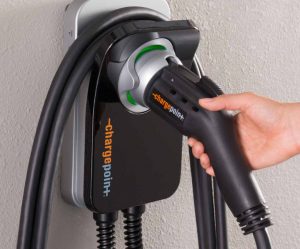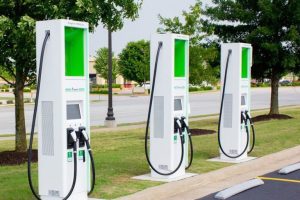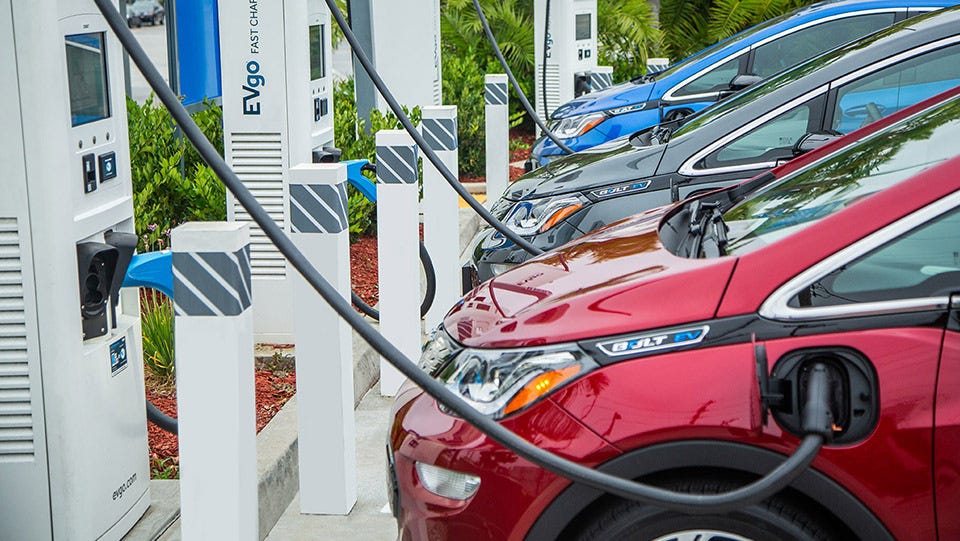When it comes to buying a battery electric vehicle (BEV) or plug-in hybrid vehicle (PHEV) for the first time, an important thing to know is how you charge electric cars. It isn’t as scary as you think!
Driving a gas-powered car, have you ever thought about how inconvenient it is to constantly have to go to the gas station? On bigger, less efficient vehicles, this can be an all too regular diversion. Now, what if you could get a gas pipeline direct to your home? That would mean you could drive anywhere in a 150-200 mile radius without diverting to a gas station! Because of the dangers involved, as well as the huge infrastructure investment required, that isn’t going to happen. However, it already exists for electric car drivers. How? You already have electricity going into your home.
For the most part, you will charge your car at your home car-port or in the garage. There is a fast-growing network of public and private charging points that you’ll have access to too. In this guide, we will cover all the issues you need to understand from the get-go and demystify this strange new world from plugging in at home to the accepted etiquette of using a public fast charger.
As you read this article, we will be looking at different speeds of chargers. Going back to the idea of a gas pipeline that fed every home, you could compare Levels 1, 2, 3, and fast chargers with the amount of pressure you got from the ‘home gas pipeline’ we imagine here. A trickle would be Level 1, a comfortable flow Level 2, a fair pressure Level 3, and a huge gush DC fast charging.
If any of these terms seem confusing or too technical, don’t worry! We have a helpful glossary at the bottom of the page.
Home Charging
Home charging using a Level 1, standard grounded 120-volt plug (like what you use to charge your phone) will get you about 4 miles of chargeback an hour. Most US commutes are less than a 40-mile round trip, and a 120V socket will give you an additional 50 miles per overnight charge if you’re only plugging in overnight. Remember, most electric vehicles have over 200 total miles of range, so you’ll have plenty of range left if you’re only using your car for commutes and plugging in on a Level 1 charger overnight.
You will pay standard electricity use fees for doing this – just a few cents per mile at most, depending on your electric utility rate. Most vehicles come with a level 1 charger when you purchase the car.

Level 1 Charger
For an added expense, you can install a 240V, Level 2 charger in your car-port or garage. With a more significant current (or ‘pressure’ in the gas comparison), you should be able to more than double your range per hour of charging over the 120V standard. Typically Level 2 fast chargers give about 25 miles of charge per hour. The cost of a level 2 charger costs anywhere from $200-$700, and install can range from $700 to over $5,000 depending on the electrical capacity of where you’re installing the charger.
Even with the added expense involved in installing the Level 2 charger, you will still find the costs per mile plummets by comparison to gasoline. The faster charger will pay for itself very quickly thanks to the minute cost of electricity over gas. Considering most people don’t purely commute in their cars but drop their kids at school/clubs/the mall as well as shop and other routines, it pays for most people to have a bit more in the battery than exactly what they require to get to work. This is why you should seriously consider a Level 2 charger.

Level 2 Charger
Level 3 chargers retail for $9,000 and up. They can pump in far more energy than you need for everyday use of the car, but should you be a taxi driver or another high mileage driver, you would feel the benefit as you could charge your car enough to drive hundreds of miles a day.

Level 3 Chargers
Another advantage of home charging is that you can get a 100% charge reasonably quickly. As we will discuss later in this guide, you will find that a direct current (DC) Level 3 or fast charger will only fast-charge the battery to 80% before slowing down to a trickle to protect the battery.
As a general rule, EV batteries last longer if you slow-charge them than if you fast-charge them regularly. Charging at home could add tens of thousands of miles to your EV battery life if you only rarely fast-charge it.
If you are driving a plug-in hybrid (PHEV), you may find that you cannot charge your vehicle any more quickly than a Level 2 charger, and Level 1 on older models.
Public Charging Stations
More and more stores, companies, and government offices are offering private access car charging stations. This means you can charge at work, at both government and private organizations, or plug-in while you shop.
You will generally find that employee and customer charging points are Levels 1 or 2 compatible and only rarely fast charging as there are considerable cost implications in installing a DC fast charger.
There are benefits for the organizations in question. Setting up a charging point can be used to help with their corporate social responsibility obligations and offset other greenhouse gas emissions.
As an employee perk, these charging stations can be invaluable, potentially allowing you to avoid installing a home Level 2 charger. As a customer at a shopping mall, you can charge your car over 3-4 hours while inside, an added benefit of visiting the stores.
Some of these charging points are free to use, though some charge a fee. Even so, these fees are still well below what your colleagues at work are paying at the gas pump. Besides, how many businesses have ever installed a gas pump in their car park for employees to use?!
Fast Charging
One of the complaints of electric vehicles is that you cannot charge them as quickly as you can a gas-powered (internal combustion engine or ICE for short) car by putting fuel in them.
You can fast-charge your car in an hour or less using a CHAdeMO, CCS, or Tesla Supercharger. In general, Japanese BEV models like the Nissan Leaf take CHAdeMO, European and US models like the Chevy Volt take CCS, and Teslas can charge at Tesla Superchargers AND CHAdeMO chargers with the proper adapters purchased. CCS can offer faster charging times (up to 300kW) than CHAdeMO though a new CHAdeMO 2.0 system that provides competitive speeds to CCS could be on the US road network soon.
Despite more and more cars hitting the road that take CCS, there are far more CHAdeMO fast chargers on the US road network than CCS at present. The market will drive this change with supply adjusting to meet demand. It won’t happen overnight, though.
For a more extended road trip using a fast-charging network, you would drive 2-3 hours and have a break to stretch your legs and eat as you recharge the car. Many electric car navigation systems will advise shorter and longer charges for a more efficient route, so you aren’t doing very long legs with long stops. A series of shorter stops and legs with one or two longer runs and longer charges will ultimately minimize your overall journey time.
The main drawback of fast charging is that it impacts long-term battery life. Essentially the more you slow-charge the battery, the less it degrades. The heat and energy exchange of a fast-charge will lead to irreversible chemical changes within the cells that will kill them off more quickly than slow-charging.
Another point to remember is that the fast charger will only charge your battery to 80% at top speed before slowing to a trickle. Again, this is to protect the battery.
Your car’s computer will limit the charging station’s power into your battery to the optimum for the vehicle. That is to say, a battery capable of taking 40 kilowatts (kW) of power hooked up to a 300kW CCS charger will only take 40kW. As battery technology improves and more cars get faster charging-capable batteries so the new owners will be able to spend less time charging and more time driving.
A final point? High powered DC charging points cost a lot of money to install, and those companies putting them in have to recover their costs. This is the reason why you will pay a lot more per kilowatt-hour of electricity on a fast charger than you will on a Level 1 or 2 charger. On every level, it pays just to trickle-charge your vehicle at home, the mall, or at work!
Charging Networks
Several businesses have got into charging in much the same way as different oil companies sell gas at the gas station. Unlike gas stations, you will not find someone in a booth nearby to pay, but instead, you will pay using a variety of means.
A common charging network system is via paid membership to access the charging points. Many (but not all) of these will offer pay-as-you-go charging, but at a higher rate than charged to members. Others are purely pay-as-you-go, but you will need a phone app to organize the charging.
To add to this, some charging companies have denser networks in some states and cities in the US than others, so on an interstate journey, you may need to join up with a number of them to have a trouble-free journey.
The array of membership and payment schemes can be confusing and irritating until you get your head around it. It is a case of knowing your territory, and once you do, you will be able to go about your business.
Charging Apps
There are a number of smartphone charging map apps that show you your nearest charging point in a given area. Tesla and other BEV in-car navigation systems also have databases of charging points that you can use to get about a city, and in Tesla’s case, much of the Western world!
Here at Steer, we have looked at many charging point mapping apps and found the highest number of charging points for the Washington DC area is with PlugShare, as can be seen in the image above.
There are other apps like Blink Network and Chargepoint. These only offer charging points on their own networks. We tend to recommend these two apps, as they have the most locations in the DC area.
These public charging points sometimes charge and are sometimes free to use. PlugShare also includes private residences that allow people to plug in for a small fee, in a similar way to Airbnb enables people to rent out their spare rooms. This has moved in on dedicated EV plug sharing apps’ territory like EVMatch, but on EVMatch, you can find certain EV evangelists who won’t charge you money to charge your car! The app originated in Southern California, so it’s still best utilized around there, but it’s slowly spreading across the country to areas like Washington DC.
Charging Etiquette
As happened with the rise of the internet in the early 1990s, a new culture has emerged around EVs as the technology has grown. Some formal and informal rules are considered the “right thing to do” among all EV users, to keep everyone happy and ultimately to help the number of users grow.
The first rule everyone should observe is that when you are using a public charging point (or at work should your office have fewer charging points than EV users), only leave your car in the parking space as long as it is charging. Someone may be travelling a distance and have too few miles to make the next charger, so it is only good form to allow charging points’ use to be maximized.
If you know you won’t be able to get back immediately when the car is at full charge, leave some contact details on your dash so people can contact you and ask you to move your vehicle for them, or allow them just to unplug yours when at full charge to plug theirs in. Newer models of EVs often have locks on the cable to prevent unwanted unplugging, so again, a polite note of how to contact you is the right thing to do.
Are you driving a PHEV? Be considerate to BEV users as they will often point out that you can operate on gas while they need electricity to get where they are going. There are BEV users that might be described as militant and who dislike PHEV users in much the same way as people of certain faiths dislike agnostics. No PHEV on the market today takes anything more than a Level 2 charge, so though you can plug into a fast charger, you will still only get a trickle from it. At times of high demand, for instance, a Friday evening, then it may pay to avoid busy charging stations for these reasons.
Ready To Get Started?
So there you have it, all you need to know about charging your electric vehicle. Not so bad, is it? If you think about it, if ICE cars were new and EVs under threat, we would likely have to write a similar in-depth piece on how you couldn’t fuel your car at home and had to pour highly flammable liquid into your tank that could explode if your cell phone goes off while doing it. You’d be just as perplexed and confused!
Additionally, with Steer, we’ll help you through your EV journey and give you a thorough walkthrough of every vehicle in our Fleet. All Steer members have access to our concierge team, who will help you find chargers near your home, help plan more extended trips, and evaluate if a home charger is right for you. We also give our members a SteerPass, which is like an EZ-Pass for chargers. It’ll spare you from having to download more apps, upload your credit card to more places, or if you, unfortunately, find yourself out in the cold trying to charge only to realize you don’t have the right card to start the charging session.
As with gas cars, once you get your head around the system and conventions, it will be easy as pie.
Happy charging!
Glossary
BEV – Battery Electric Vehicle. A car without a gas engine that purely runs on batteries.
PHEV – Plug-in Hybrid Electric Vehicle. A car with a gas engine and electric motor. At lower speeds, these will use the battery and at higher speeds, the gas engine. When the battery runs out, you use gas all the time.
ICE – Internal Combustion Engine – a gas-powered car with no electric motor.
Level 1 charging – Charging from standard 120 volt A/C mains power.
Level 2 charging – 240V A/C power that can be drawn from the electricity grid. Can more than double your charging speed over 120V A/C.
Level 3 charging – a direct current (DC) charging unit you can install at home, usually up to 40 kilowatts (kW). These are far more expensive than Level 2 and only useful should you be a very high annual mileage driver.
CHAdeMO – “Charge de Move” – a Japanese standard fast-charging protocol capable of 62.5 kilowatts. Currently, this is more than most mid-range electric cars can take (bar Teslas) though Porsche and other luxury end automakers are releasing cars capable of a far bigger charge from CCS.
CCS – Combined Charging Standard – European and US automakers’ preferred fast-charging system, currently capable of up to 300kW of power. Most non-Teslas will only take up to 40kW, though the new Porsche Taycan can take the full 300kW.
Tesla Supercharger – Only for Tesla cars, capable of delivering up to 150kW depending on age and model of vehicle.
kW – kilowatt. Watts are a measure of power worked out by multiplying amps by volts. A kilowatt is a thousand Watts.
kWh – kilowatt-hour. A measure of storage in a car battery. This could be compared to knowing the size of your gas tank. Top-end Teslas have 100kWh battery banks while smaller city cars can be 20kWh or smaller. – https://www.steerev.com/













